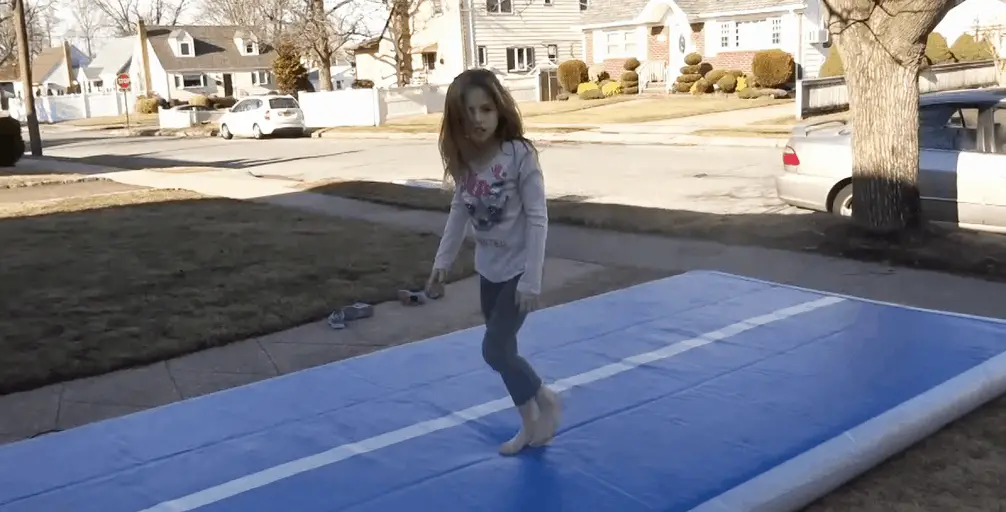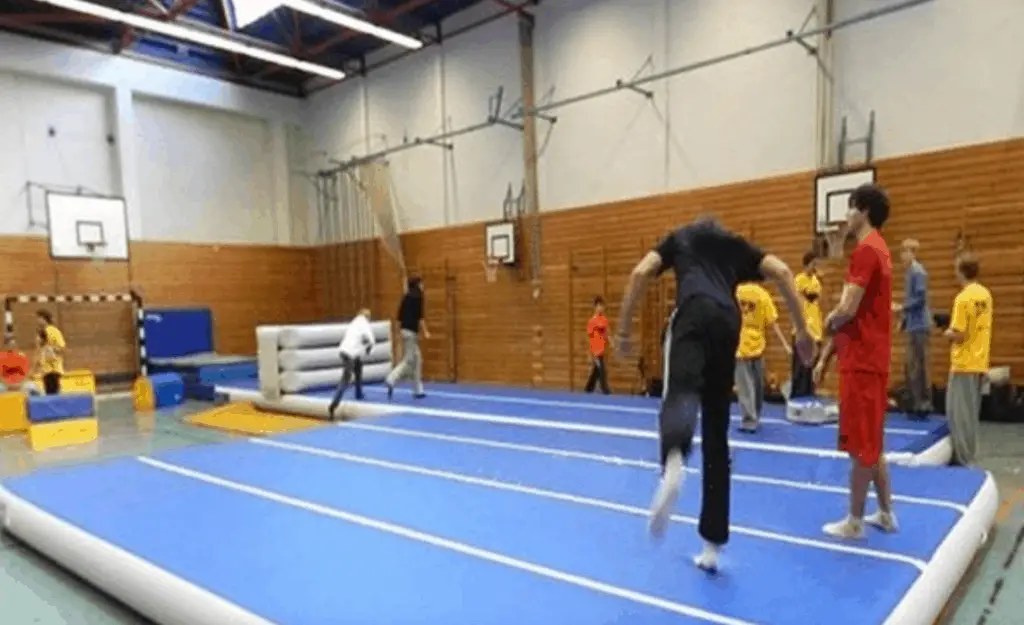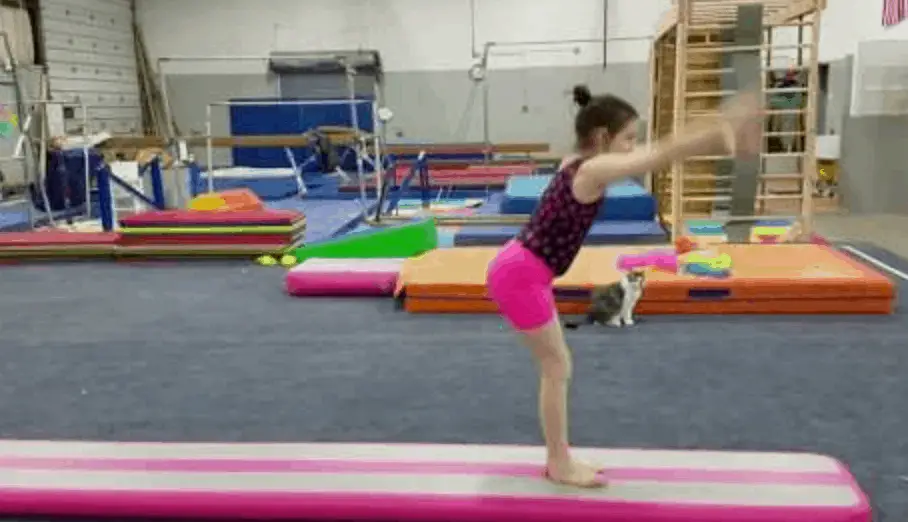You have likely heard that you can practice a lot of gymnastics skills on a gymnastics air track. However, perhaps you are wondering just what skills these are. There are so many individual gymnastics skills that it would be impossible to list them all here.
What skills can you practice on a gymnastics air track? Almost any gymnastics skill that you do on the floor, balance beam, or for vaulting can be done on your gymnastics air track. This gives you a lot of skills that you can practice on your air track.
It is important to know what skills you can train with on your air track to get the most use out of it. However, some of the skills you can work on depends on the length of your air track, what skills you are working on, what level you keep your air pressure in the track at, and many other small details.
The Length Of Your Air Track
When determining what skills you can practice on your gymnastics air track, the first thing that makes a difference is the length of your track. Gymnastics air tracks can vary quite widely in their length. On that same note, different gymnastics skills require a certain amount of space to do as well.
Small air tracks are under 10 feet long, sometimes being as small as 3 feet wide by 3 feet long. This size of an air track does not give you much space to practice skills on. However, you can use it to practice skills like your front and back walkovers.
You can also use a track of this size to land on at the end of a flip. Tracks that are closer to 10 feet allow you to do a full backflip, front-flip, or roundoff on them without running out of space. This small size allows you to take an air track of this size with you more.
Medium-sized air tracks are around 15 to 20 feet, and these are the right length for practicing the first of your combined skill. A roundoff into some form of a salt, for example, is a fairly common combination that can be challenging at first to accomplish in a straight line.

Your running start would take place off of the mat, and your skills would be done on the mat itself. This will give you room on your track at the end so that if you fall, you do not end up falling off of the end of your track.
The largest air tracks can be well over 30 feet long. These can be used for longer combinations of gymnastics skills. As you progress, you may even be able to do some of the full tumbling passes on a track this long.
Your Skill Level
What skills you can practice on your gymnastics air track also depends some on what your skill level is. If you can barely do a walkover, for example, then you are probably not going to be practicing roundoffs or saltos on your air track.
New gymnasts should start off on their air track doing some of the simple things like tucked rolls and cartwheels. Backward rolls are a great way to get yourself used to the sensation of falling backward, which can prepare you for other backward skills.
As you get a little better at gymnastics, you will reach the point where you will want to work on your roundoffs. A roundoff is one of the most common gymnastics skills that is one of the building blocks of many of the different combination skills.
It can be particularly challenging at first to align your body just right when doing a roundoff so that you end facing the right direction. From there, gymnastics skills such as saltos and handsprings require quite a bit of time to master as well.
Having falls when you are learning to do flips of any kind are common, which is why these are skills that it is particularly good to practice on an air track. You should not start doing combinations of skills until you have at least gotten the hang of doing each of the individual skills that make up the combination.
However, working on the building blocks of combination skills at home can be a huge help for when your coach decided you are ready to put them together. The extra practice on these skills can help you put them together easier when you reach that stage.
Skills For The Various Events
Along with different levels, there are also different events in gymnastics. Almost all of these events have skills that can be practiced on a gymnastics air track. The one exception is the uneven bar skills. However, it is still possible to set up an uneven bar over your air track.

So, in a way, your air track can literally be used for skills that belong to every gymnastics event. However, the floor, balance beam, and vaulting skills are the ones that are the most straightforward events when it comes to using your air track.
Floor Skills
On your air track, the skills that you are most likely going to work on are your floor skills. Air tracks are not wide enough to do your whole floor routine. But, if you pause and move back to the beginning of the track, you can practice virtually all of the different floor skills for gymnastics.
These skills range from everything from the tucked rolls, to your tumbling passes. Your air track can provide a good way to test out parts of your floor routine so that you can see how different skills might work with each other while you are trying to figure out what skill to put where in your routine.
Balance Beam Skills
Many of your balance beam skills are the exact same as your floor skills; they are simply done on the beam instead of on the floor. Mounting and dismounting skills cannot really be practiced on an air track; neither can skills that have one or both legs drop below or to the side of the beam.
Other than those skills, an air track is good practice for the beam skills thanks to the lines on the air track that assist you in learning your skills in a straight line. Since a balance beam is not very wide, it is essential to learn how to do your gymnastics skills in as perfectly a straight line as possible.
Vaulting Skills
While fewer gymnasts use their air track for vaulting, an air track is actually one of the best ways to practice your vaults. If you get your running start before reaching the leading edge of the mat, you can do even the more complicated vaults, including the entries for them.
This is possible by setting up a rectangle foam shape or something else on top of your air track. There are a couple of gymnastics companies that sell things like this that are specifically made to be used on air tracks. While this is not exactly the same as an actual vaulting table, they will work for you to train at home.
Final Thoughts
As you can see, air tracks can be used for countless gymnastics skills for almost all events and no matter your level. Your own height does play a small role in how much space you need on your track since taller people need more length than a smaller person does.
Repetition is one of the key parts of learning gymnastics skills. Doing the same skill over and over again, especially the simple skills, helps you build up muscle memory. When you can do a complicated gymnastic skill perfectly without even thinking about it, you have done it enough to have developed muscle memory.
You can get gymnastics lessons multiple days a week, but in your lessons you will most often be learning new skills or working out the kinks in some of the ones you already know. Practicing at home on your air track is something that you need to do to ingrain what you have been learning into your muscles.

